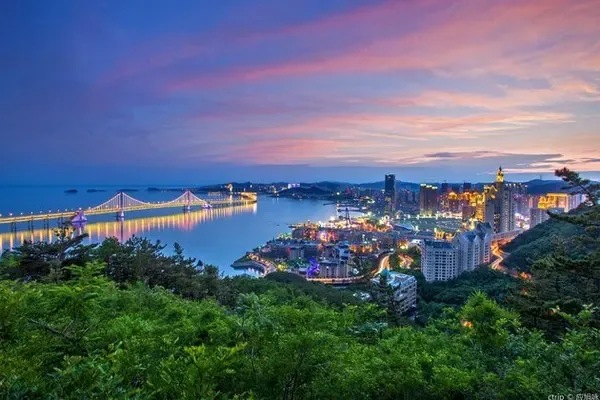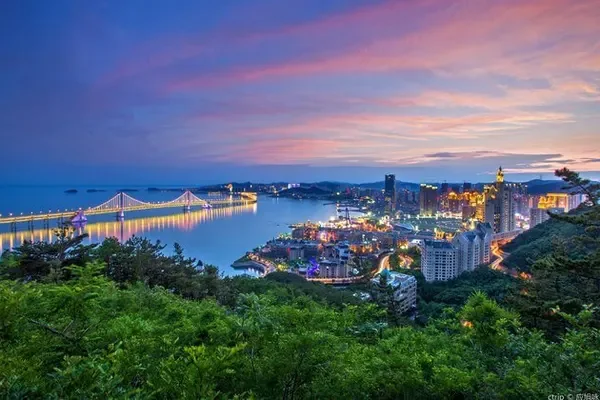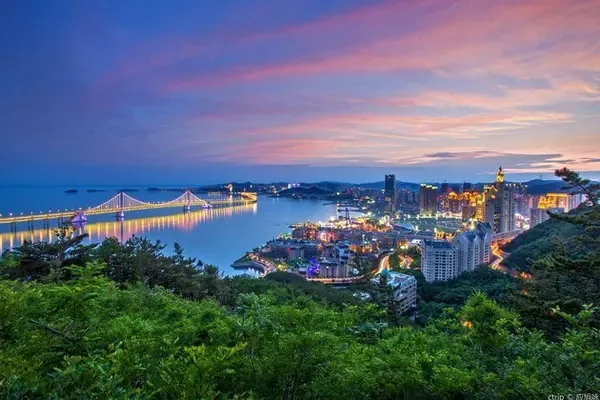Beixinqiao with sea eyes
Why is this place called Beixinqiao? According to legend, Zhu Yuanzhang had a dream in the Ming Dynasty. In the dream, there was an old dragon king. The old dragon king said that your crime of killing for years is too deep. In order to punish you, I will take away all the water in Beijing. After Zhu Yuanzhang woke up, he found Liu Bowen. Why did he find Liu Bowen, because Liu Bowen built Beijing City according to the image of the eight-armed Nezha, and asked him to find a way to restrain the old dragon king. Liu Bowen found a general, Gao Liang, and asked him to find an old couple pushing a water wheel outside the east gate, stab the water wheel and run away. After Gao Liang arrived at the East Gate, he saw that there was an old couple pushing a waterwheel to rest on the side of the road. They pierced the waterwheel when they went up, and then ran back. When they came to the Meridian Gate, they looked back and saw the huge waves several feet high behind them. Leaping towards him, Gao Liang was buried in the water. It turned out that the old couple were the Dragon King and his wife. They wanted to take away all the water in Beijing, but they were destroyed by Gao Liang, and the water remained. If the old dragon king came to make trouble again, he had to pass through the sea eye to enter the city of Beijing. At that time, there were several sea eyes in Beijing, and all of them were blocked except for Beixin Bridge. Liu Bowen asked "Jiang Zhu" to block the sea eye, and told him that the bridge here is getting old, so you come out again. Later, in order to prevent the old Dragon King from making trouble again, Liu Bowen renamed the bridge here as Beixin Bridge, and the sea eyes here have been permanently preserved.
There is a Gui character on the wall of the street east of Beixinqiao intersection, which is Gui Street, a famous restaurant street in Beijing. It is called Dongzhimen Inner Street on the map. In the past, there were many 24-hour shops on this street. Many people came here to find food at night. The common people called it Ghost Street. Because it sounded bad, it was officially changed to Guijie Street.
Going north after exiting Beixinqiao Subway Station, there is the earliest Internet celebrity shop in Beijing, Master Bao Pastry, on the side of the road. They say that his meat floss cake is delicious, but I like peach cake the most.
If you are visiting the old districts of Beijing, it is better to stay in a courtyard hotel to experience the traditional culture of old Beijing.
Accommodation: Unnamed Courtyard Hotel


This hotel is located at No. 38, Baochao Hutong, Nanluo Guxiang. It is an antique Beijing courtyard hotel. It used to be the residence of Ren Zan, a third-rank military officer in the middle of the Qing Dynasty. When I first entered the room, I was not surprised, but from the outside When I am tired after playing, I will appreciate the benefits of this hotel. There are self-service fruits, rice dumplings suitable for the occasion, tea and sofas in the courtyard. It is a typical courtyard hotel in old Beijing that is more comfortable and comfortable.
Lama Temple
The Lama Temple (The Lama Temple) is located in the northeast corner of downtown Beijing. In the 33rd year of Emperor Kangxi of the Qing Dynasty (1694), Emperor Kangxi built a mansion here and bestowed it on his fourth son, Prince Yong, and called it Prince Yong's Mansion. In the third year of Yongzheng (1725), the palace was changed into a palace, called Lama Temple. In the thirteenth year of Yongzheng (1735), Yongzheng died, and the coffin was parked here. Therefore, the original green glazed tiles of the main hall of Lama Temple were changed to yellow glazed tiles. Because Emperor Qianlong was born here, and two emperors came out of Lama Temple, it became the "Longqian blessed place", so the palace has yellow tiles and red walls, which is the same specification as the Forbidden City. In the ninth year of Qianlong (1744), the Lama Temple was changed into a Lama Temple, and the Minister of Prime Minister Affairs Wang was appointed to manage the affairs of the palace without a fixed number of staff. It can be said that the Lama Temple is the highest-standard Buddhist temple in the country in the middle and late Qing Dynasty.
The ticket for the Lama Temple is a small CD, which can be collected. Three free incense sticks will be given out when you enter the door. There are no incense sellers in the temple, and private incense bought outside is not allowed to be brought into the temple. Please pay attention.
The most famous Lama Temple in Beijing is not only because it was the residence of Yongzheng, but because of its porridge on the day of Laba Festival. Laba porridge in Lama Temple has existed since the Qing Dynasty. It is said that Laba porridge in Lama Temple has a set of etiquette when cooking. According to the "Yonghe Palace Chronicles", the Laba Festival is divided into four scenes: porridge offering, porridge offering, porridge offering, and porridge shedding. From the first day of the first month of the twelfth lunar month, the Office of Internal Affairs, which is in charge of the Ministry of Internal Affairs, has sent staff to deliver the first-class butter, millet, glutinous rice, diced mutton, and whole grains, as well as dried fruits such as red dates, longan, walnut kernels, raisins, melon seeds, and green red shreds. The cars are shipped, and they will be shipped on the fifth day of the lunar new year. The fire is lit in the early morning of the seventh day, and all the porridge can be cooked in the early morning of the eighth day. A total of six pots were boiled, the first pot was dedicated to the Buddha; the second pot was dedicated to the emperor and the palace. This pot of porridge was more exquisite than the one dedicated to the Buddha. Jujube paste is piled up to mold the old man of longevity, the Eight Immortals, etc., and various patterns such as Zhuofu, Lu, Shou, Jubilee and so on. The third pot is given to princes, ministers and great lamas; the fourth pot is given to civil and military officials and local officials in various provinces; the fifth pot is distributed to all lamas in Lama Temple; Laba porridge as alms. Of course, the materials used are not as good as one pot.
It is already a tradition in Beijing to "shack porridge" in the Laba Festival of Lama Temple. In 2019, there were 98 pots of "shack porridge" in Lama Temple, and more than 8,500 citizens drank steaming Laba porridge. But those who want to drink porridge must be prepared to be squeezed.


Go out of the Lama Temple and go north along the street to Chengxian Street. The first stop on the left is the Confucius Temple.
Pailou Street Guozijian Street
Guozijian Street was formed in Yuan Dynasty. In the Ming Dynasty, it was called "Guozijian Confucian Temple". In the Qing Dynasty, it was called Chengxian Street. After the Republic of China, it was called Guozijian. In 1965, it was called Guozijian Street. There are four archways on Guozijian Street, and two on the east and west at the entrance of the street. The archway is called "Chengxian Street".
Guozijian Street is the only street in Beijing with archways. There are four archways on the street, one at the entrance of the East and West Streets, with the inscription "Chengxian Street", and one on the left and right near the Guozijian, with the inscription "Guozijian".


You can still look around on this street. I remember that there seems to be a furniture seller, all of which are cold. The favorite vegetarian restaurant, Xuxiangzhai, is gone, and there are other small shops that are also good.
The place to worship before the exam - Confucius Temple
Beijing Confucian Temple, also known as "Xianshi Temple", was the place where Confucius was worshiped in Yuan, Ming and Qing dynasties in China. Together with the Confucius Temple in Nanjing, the Confucian Temple in Jilin and the Confucian Temple in Qufu, it is known as the four major Confucian Temples in China. It was first built in the sixth year of Dade in the Yuan Dynasty (1302), completed in the tenth year of Dade (1306), and rebuilt in the ninth year of Yongle in the Ming Dynasty (1411). Covering an area of 22,000 square meters. During the Xuande, Jiajing, and Wanli years, the main hall was repaired and the Chongsheng Shrine was added, and it was rebuilt during the Shunzhi, Yongzheng, and Qianlong periods of the Qing Dynasty. In 1906 (the 32nd year of Guangxu), the main hall was expanded. Although the Confucian Temple has been rebuilt in successive dynasties, its structure basically still retains the style of the Yuan Dynasty. The entire Confucian Temple is divided into three courtyards, covering an area of about 22,000 square meters. It adopts a traditional Chinese architectural layout with the main buildings distributed along the central axis and symmetrical left and right. The buildings on the central axis are Dacheng Gate, Dacheng Hall, Chongsheng Gate and Chongsheng Temple from south to north. There are glazed walls and dismounting steles in front of the gate, and there are stele pavilions, divine kitchens, divine warehouses, etc. in the east and west of the gate, with inscriptions of more than 50,000 Jinshi in the past dynasties. There are 198 steles inscribed by Jinshi from Yuan, Ming and Qing Dynasties.



The first thing to see here is the ancient tree. The young ones are all 100 years old. There is a cypress in front of the Dacheng Hall. It is said that Yan Song, the traitor of the Ming Dynasty, once offered sacrifices to Confucius on behalf of Emperor Jiajing, because only the emperor offered sacrifices to Confucius in the Dacheng Hall. Yan Song was supposed to offer sacrifices outside the hall, but the domineering Yan Song insisted on showing his majesty and feeling what it was like to be an emperor. When he passed under the ancient cypress tree, a sudden gust of wind blew up and the branches and leaves of the cypress Shaking, an outstretched cypress branch scraped off his black gauze hat, and Yan Song fled in fright. Later, he was convicted because of the crime, and was taken off the black hat, and finally starved to death on the street, without a good death. The people suffered a lot because of their domineering and evil deeds, so they believed that this ancient cypress had spirituality and could distinguish loyalty from traitors, so they called this tree "Touching Traitor Cypress" or "Distinguishing Traitor Cypress". Since this ancient cypress picked off Yan Song's black hat, a large tumor has grown on the trunk, which looks like an ugly face when viewed horizontally, and the branch that scraped off the black yarn has withered, leaving a ray of light The bald branches are lying there, as if they are telling history and persuading people to do good.

The second is the Forest of Jinshi Steles, on which are engraved the lists of Jinshi named on the gold lists of the Ming and Qing dynasties. There are 198 steles in total, including 3 in the Yuan Dynasty, 77 in the Ming Dynasty, and 118 in the Qing Dynasty. The stele is engraved with the name, order and borrowing of Jinshi. There were 51,624 Jinshi and No. 1 candidates in the imperial examinations of the Ming and Qing dynasties (including No. 1 Scholar, No. 2, and Tanhua). You can find steles of Jinshi of Yu Qian and Yuan Chonghuan, famous figures in the Ming Dynasty, and Lin Zexu and Shen Junru in the late Qing Dynasty.
The inscription stele in the courtyard of the Confucius Temple was established after the second year of Yuanhuangqing (1313) when he was admitted as a scholar. Jinshi inscribed their names on the stele to show off their ancestors. In the Ming Dynasty, the engraved names of the Yuan Dynasty were often rubbed off, and the names of the Jinshi of the Ming Dynasty were engraved on them. Therefore, there are not many inscriptions in the Yuan Dynasty.



There are performances on the hour. The most popular time for the Confucian Temple is actually before the college entrance examination every year. Parents bring their children to worship Confucius. Many years ago, there was a place where the wishing card was attached. I don’t know if it still exists now.
The ancient Central Party School Guozijian
In the tenth year of Yuan Dade (1306), Beijing Guozijian was founded. It was originally called Beiping Junxue. As of 2017, it has a history of 711 years.
The Guozijian of the Ming Dynasty was founded when the Ming Taizu first established Jinling, and it was changed from Yingtianfu School to Guozi School. Later Taizu established the capital in Nanjing, rebuilt the school building at the foot of Jiming Mountain, and changed the school into a prison, so it was called Guozijian. In the eighth year of Hongwu, the Guozijian of Zhongdu was set up in Fengyang. In the twenty-sixth year of Hongwu (1393), Fengyang Zhongdu Guozijian was abolished, and its teachers and students were merged into Nanjing Guozijian. At this time, the number of students in Nanjing Guozijian had increased to more than 8,000. In the second year of Yongle (1404), Beiping County School was renamed Guozijian. In the eighteenth year of Yongle (1420), the Ming Dynasty moved its capital to Beijing, and changed the Beijing Guozijian to the Jingshi Guozijian. Therefore, the Ming Dynasty Guoxue was divided into the North and the South (also known as the North and the South). In the 20th year of Yongle (1422), there were more than 9,900 people in Nanjing Guozijian, which was an unprecedented event. At that time, neighbors Korea, Japan, Ryukyu, Siam and other countries "recommended culture and education" and sent overseas students to Nanjing Guozijian to study. But this kind of grand occasion was short-lived, and after Zhengde, it gradually declined.
In the seventh year of Shunzhi (1650), Nanjing Guozijian was changed to Qing Jiangning School. Due to the old system of the Ming Dynasty in the Qing Dynasty, the ancestors began to repair the Guozijian in Beijing. According to the "Qing History Draft · Election Records" records: "The ancestors established Yanjing, and repaired the Northern Supervisor of the Ming Dynasty as the Taixue. In the first year of Shunzhi, set up sacrificial wine, Siye and Jiancheng, doctors, teaching assistants, Xuezheng, Xuelu, and Dianbo Waiting for officials. Set up six halls as lecture places, saying: straightforwardness, Taoism, sincerity, justice, aspirations, and broad career. One is still clear." During the Qianlong period, Guozijian imitated the teaching method of Hu Yuansuhu, a famous Confucian in the Song Dynasty, and divided the teaching of classics and righteousness into governance and affairs. It is a commendable scene of working hard, researching and seeking practical learning". However, the increasing corruption in the late Qing Dynasty made the school a vassal of the imperial examinations, and the superintendent Dona Su entered the school, studying for the fame and fortune of the department, so that it was hard to return.
In 1902, Nanjing Qing Jiangning School established Sanjiang Normal School (the predecessor of Nanjing University) on the basis of Sipailou Jiangning School. On December 6, 1905 (the thirty-first year of the reign of Emperor Guangxu), the school system was reformed in the late Qing Dynasty, and the Department of Education was established.


You don't need to go out of the Confucian Temple, you can go west in the courtyard to the Guozijian. Some people say that Guozijian is Tsinghua University, and some people say it is Peking University. I think the most accurate definition should be the Central Party School.









When I went there last year, I ran into an old man who had a chat. He lives in Peony Garden and came here by car. He used to be an artist, so he loved painting old buildings in Beijing. After leaving Guozijian, the Hutong to the north of Guozijian Street is Wudaoying Hutong.
Elegant Wudaoying Hutong


The last time I went was a few years ago. Compared with Nanluo, there are fewer people and quieter. There are no grilled chips and big squid. It is not so noisy. It is more petty bourgeoisie. I didn't tell you so blatantly that this is a tourist street, come and buy it, ladies and gentlemen.

You can lie on the street and drink.
It is not my dish like bayberry and bamboo, so I won't say much. Exiting the west entrance of Wudaoying is Andingmen Inner Street.
Eat and drink inside Andingmen
Every time I mention Andingmen, I can think of the famous Anding Hospital. Should I also visit Anding Hospital?
When you come to Andingmen, you just come to eat. One is the old Baikui restaurant, and the other is Lanyue Zhai. A few days ago, the classmate reunion was Lanyue Zhai.


Day 4 map



